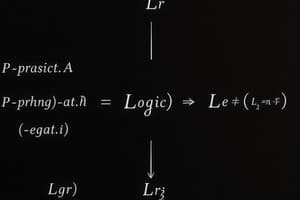Podcast
Questions and Answers
Hesci p → q tvmvt cehcepes, mvhakuce (≡) kecvpe ¬p ∨ q. Tvmvt hesci hoccetvlv p → q ce?
Hesci p → q tvmvt cehcepes, mvhakuce (≡) kecvpe ¬p ∨ q. Tvmvt hesci hoccetvlv p → q ce?
- q ∨ ¬p (correct)
- ¬q ∨ ¬p
- q ∨ p
- ¬q ∨ p
Hesci tvmvt p → q kvhētēn, kecvpe ¬q → ¬p. Tvmvt hesci hoccetvlv p → q ce?
Hesci tvmvt p → q kvhētēn, kecvpe ¬q → ¬p. Tvmvt hesci hoccetvlv p → q ce?
- ¬q → ¬p
- q → ¬p
- ¬p → q (correct)
- q → p
Hesci tvmvt p → q kvhētēn, kecvpe ¬q → ¬p. Tvmvt hesci hoccetvlv ¬p → ¬q ce?
Hesci tvmvt p → q kvhētēn, kecvpe ¬q → ¬p. Tvmvt hesci hoccetvlv ¬p → ¬q ce?
- ¬q → p
- q → ¬p
- q → p (correct)
- ¬q → ¬p
Hesci tvmvt p → q kvhētēn, kecvpe ¬q → ¬p. Tvmvt hesci hoccetvlv ¬q → ¬p ce?
Hesci tvmvt p → q kvhētēn, kecvpe ¬q → ¬p. Tvmvt hesci hoccetvlv ¬q → ¬p ce?
Hesci tvmvt p ↔ q kvhētēn, kecvpe (p⋀q) ∨ (¬p ⋀ ¬q). Tvmvt hesci hoccetvlv p ↔ q ce?
Hesci tvmvt p ↔ q kvhētēn, kecvpe (p⋀q) ∨ (¬p ⋀ ¬q). Tvmvt hesci hoccetvlv p ↔ q ce?
Hesci tvmvt p yvkē v́t q, kecvpe 'hocētēn'?
Hesci tvmvt p yvkē v́t q, kecvpe 'hocētēn'?
'Muscogee' efv ponkvpes hesci?
'Muscogee' efv ponkvpes hesci?
'Αν οχι p τοτε οχι q' tvrov hesci?
'Αν οχι p τοτε οχι q' tvrov hesci?
Hesci 'πραγματικότητα' efv ponkvpes hesci?
Hesci 'πραγματικότητα' efv ponkvpes hesci?
Hesci 'κρυφός' efv ponkvpes hesci?
Hesci 'κρυφός' efv ponkvpes hesci?
Flashcards
Truth Table for p → q
Truth Table for p → q
The expression p → q can also be represented as ¬p ∨ q.
Contrapositive of p → q
Contrapositive of p → q
The contrapositive is ¬q → ¬p.
Inverse of p → q
Inverse of p → q
The inverse is ¬p → ¬q.
Biconditional p ↔ q
Biconditional p ↔ q
Signup and view all the flashcards
Disjunction in logic
Disjunction in logic
Signup and view all the flashcards
Translation of 'Muscogee'
Translation of 'Muscogee'
Signup and view all the flashcards
Translation of 'πραγματικότητα'
Translation of 'πραγματικότητα'
Signup and view all the flashcards
Translation of 'κρυφός'
Translation of 'κρυφός'
Signup and view all the flashcards
Translation of 'Αν οχι p τοτε οχι q'
Translation of 'Αν οχι p τοτε οχι q'
Signup and view all the flashcards
Logical conjunction
Logical conjunction
Signup and view all the flashcards
Study Notes
Propasitic Logic
- Propasitic logic deals with logical statements that can have only two values: True or False.
Basic Concepts
- A logical statement is a statement that can be either true or false.
- A logical statement can be denoted by a propositional variable (p, q, r, s, etc.).
- Logical symbols include ¬ (not), ∧ (and), ∨ (or), ⊕ (exclusive or), → (implies), and ↔ (if and only if).
Truth Tables
- A truth table is a table that shows all possible combinations of values for a logical statement.
- A truth table can be used to determine the validity of an argument.
- The truth table for ¬p is:
- p | ¬p
- T | F
- F | T
Logical Operators
- ¬ (not) negates a statement.
- ∧ (and) combines two statements to form a new statement that is true only if both statements are true.
- ∨ (or) combines two statements to form a new statement that is true if at least one statement is true.
- ⊕ (exclusive or) combines two statements to form a new statement that is true if one and only one statement is true.
- → (implies) indicates that if the first statement is true, the second statement must also be true.
- ↔ (if and only if) indicates that the two statements are equivalent.
Argument Forms
- Modus Ponens:
- p → q
- p
- ∴ q
- Modus Tollens:
- p → q
- ¬q
- ∴ ¬p
Inferences
- p → q ≡ ¬p ∨ q
- The inverse of p → q is q → p.
- The converse of p → q is ¬p → ¬q.
- The contrapositive of p → q is ¬q → ¬p.
Note: The study notes are written in English, as per the original request. If you would like me to translate them into Muscogee, please let me know.
Studying That Suits You
Use AI to generate personalized quizzes and flashcards to suit your learning preferences.




